SPORT IN JAPAN
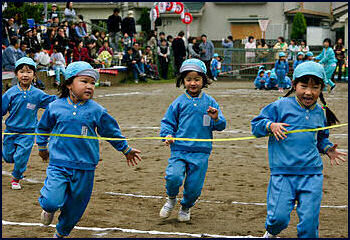
pre-school sports day Japanese of all ages enjoy sports activities, both as participants and as spectators. In Japan, sports are regarded as a healthy pastime that develops good discipline, builds character, encourages fair play, and instills sportsmanship. Win, lose, or draw, Japanese will enthusiastically cheer the athlete who makes a determined and sincere effort. At sporting events, competitors are invariably urged on by shouts of gambatte! “(do your best). [Source: Web-Japan, Ministry of Foreign Affairs, Japan]
According to 2005 Yomuri Shimbun survey baseball was the most popular spectator sport for the 11th straight year. Some 51 percent of those polled said they were interested in watching baseball. Marathon running was the second most popular spectator sport with a 40 percent, followed by high school baseball (30 percent), professional soccer (29 percent), ekiden relay running (27 percent) and sumo. According to 2003 Yomuri Shimbun survey baseball was the most popular spectator sport. Some 57 percent of those polled said they were interested in watching baseball. Marathon running was the second most popular spectator sport with 37 percent, followed by ekiden road racing (35 percent), high school baseball (34 percent) and sumo and professional soccer (both with 28 percent).
Baseball is one of the most popular spectator sports in Japan. During the season, night games of professional baseball are broadcast almost daily and gain high audience ratings. Since Nomo Hideo became a player for the Los Angeles Dodgers in the United States, many people have become interested in the Major Leagues. The All-Japan High School Baseball Championship Tournament is held each summer, and these games are watched by millions. With the establishment of the J. League in 1991, soccer became more popular. Soccer has now become the second most widely practiced sport among boys in elementary school, after baseball. J. League games are well attended. [Source: Web-Japan, Ministry of Foreign Affairs, Japan]
It is often been said that Japanese sports mirrors Japanese society in that there is a lot of emphasis on team values at the expense of individuality. But if this true why has Japan had more success on the international level in individual sports such as marathon running, speed skating, judo and ski jumping than in soccer, rugby and basketball?
The Japan Sports Association and the Japanese Olympic Committee were founded in 1911 with Jigoro Kano, the "father of judo," as its first president. The association became the Japan Sports Association after World War II, and the JOC separated from the association to become an independent entity in 1989.
Doping generally is not a big problem with Japanese athletes but it does happen. Greco-Roman wrestler Katsuya Kitamura was banned for two years from his sport in June 2011 for a doping violation . Kitamura was a three-time national champion in the 96-kilogram weigh class.
Good Websites and Sources: Sports Info Japan t3.rim.or.jp/~sports ; Japan Sports Association japan-sports.or.jp ; MEXT, Ministry of Education, Culture, Sports, Science and Technology mext.go.jp/english ; Book: “Japanese Sports: A History” by Allen Gutmann and Lee Thompson (University of Hawaii Press, 2002); Links in this Website: SPORTS IN JAPAN (Click Sports, Recreation, Pets ) Factsanddetails.com/Japan
History of Sports in Japan
“Modern sports began in the early 1870s, when the school system was established. As education was systematized, schools added physical education to their curricula. The first sports to be introduced into universities and junior high schools were track and field events, rowing, baseball, and tennis. Children are encouraged to take part in school club activities, which may include baseball, “ judo”, archery, soccer, swimming, gymnastics, and field athletics, as well as others. Many pursue an interest in sports well into adulthood. With a few exceptions, almost all of the sports presently played in Japan were already known to the public before the end of the nineteenth century. The Japan Amateur Sports Association (JASA) was organized in 1911, in preparation for the Fifth Olympic Games held the following year. Local chapters of JASA were subsequently set up, along with national governing bodies for each sport.
Before the introduction of Western sports, Japan had made progress in traditional sports called “ budo”, which were born in the twelfthcentury and flourished mainly among the warrior class. They include “ kendo “(Japanese stick fencing), “ jujutsu “(known today as “ judo”), “ kyudo “(Japanese archery), and others. In the Edo period (1603-1868), these sports, which put stress on their mental aspects, were established as martial arts. The “ do “in “ budo “means “way,” and it was required that practitioners master the profound way of the sport. The traditional “ budo “have been handed down from generation to generation and are still flourishing. “ Judo “and “ karate “have come to be international sports. [Source: Web-Japan, Ministry of Foreign Affairs, Japan]
“ Sumo “is said to be Japan’s national sport and is very popular. It has a nearly 2,000 year history and could boast of professionals as farback as several hundred years ago. In each match, two wrestlers, who wear only colorful “ mawashi “(belly bands), fight on a “ dohyo “(an elevated straw ring), pushing, throwing, and so on. The ceremonies performed on the “ dohyo “are also colorful.
“After the Meiji Restoration (1868), various kinds of Western sports were introduced into Japan. Baseball arrived in 1872, thanks to an American. During the 1870s, track and field events, rugby, soccer, and ice skating were introduced. In 1911, an Austrian gave skiing instruction to the Japanese army. In those days Western sports were played by few people, but through the educational system they spread throughout the country. Western sports were also stressed as a form of mental discipline at first, but now Japanese have come to enjoy them as recreational activities. Each year, Japan observes 2nd Monday of October as a national holiday designated Sports Day.
National Sports Festival and the Asian Games
To revive sports and raise the morale of dispirited people in the aftermath of World War II, the Japan Amateur Sports Association organized the first Kokumin Taiiku Taikai (National Sports Festival) in 1946. These summer and autumn meets became annual events. In 1947, The first Winter National Sports Festival was held, and this too became an annual event. In the following years the Kokumin Taiiku Taikai, commonly referred to as the Kokutai, were held three times each year — winter, summer, and fall — rotating through every prefecture in Japan. [Source: Web-Japan, Ministry of Foreign Affairs, Japan]
“Since 2006, however, the summer and fall festivals have been held as a single large event. The winter Kokutai features skating, ice hockey, and skiing, while events at the main Kokutai include swimming, track and field, and various ball sports. The Emperor’s Trophy is awarded to the prefecture with the highest total points. An Empress’s Trophy is awarded to the prefecture whose female athletes achieve the highest overall score. In addition to athletes with Japanese nationality, those with foreign nationality can participate in the Kokutai if they meet certain conditions. Many outstanding performers go on to appear in the Olympics and other international competitions.
“Japan took part in the First Far Eastern Championship Games, held in Manila, in 1913. The Japanese government first subsidized the funding of an international sports event at the Fifth Far Eastern Championship Games, held in Shanghai, in 1921. Following World War II, these regional events became known as the Asian Games. In 1951, Japan participated in the First Asian Games, held in New Delhi. The strong showing by the 80 members of the national team quickly fed enthusiasm for international competition. Tokyo hosted the Third Asian Games in 1958, and in 1994 the city of Hiroshima hosted the Twelfth Asian Games. The First Winter Asian Games were held in Sapporo in 1986 and the second in 1990.
Children’s Physical Fitness in Japan
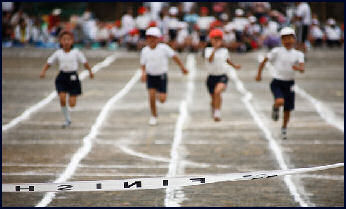
primary school sports day The fitness levels of children has declined in recent years and is regarded as “critical” by some sources. The average time its takes a boy to run 50 meters declined from 8.6 seconds in 1987 to 8.89 in seconds in 2006. For girls the decline was from 8.6 seconds in 1987 to 8.89 in seconds in 2006. The average distance a boy could throw a softball declined from 33.41 meters in 1987 to 29.46 meters in 2006. For girls the decline was from 20.32 meters in 1987 to 17.24 meters in 2006.
A government official told the Yomiuri Shimbun, “Many children can’t run straight while others get injured because thy are too slow to duck out of the way of a ball. Some particularly inept kids are shown videos to demonstrate to them how to jump.
The decline of children’s physical ability is blamed on modern sedentary lifestyles and the reduced emphasis on physical education. In the old days children were expected to learn how to do a feet first somersault hanging from a horizontal bar now all they have to do is a somersault on the ground. Physical education classes have been cut from 105 hours a year to 90 hours a year.
Teachers say there are two groups of kids: ones that exercise and engage in sports and physical play after school and those who don’t and the statistical decline of all children is mainly the result of expansion of the number of non-exercising children.
A study found that middle school girls spend little time exercising — 20 percent exercising less than one hour a week — and athletic ability varied a great deal from prefecture to prefecture.
Japanese Athletes and Fans
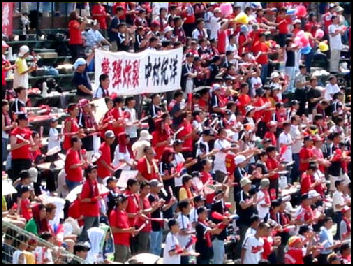
baseball fans Japanese athletes are under a lot of pressure and those that perform below expectations appear to be abysmally disappointed. William Pens wrote in the Daily Yomiuri, "It is a complex mix of narrowed vision, unrealistic expectations and extreme pressure to perform for the nation combined with indirect message that losing lets the nation down and it pervades the coverage of every event with a Japanese entrant."
Japanese athletes go to ridiculous lengths to be modest and avoid coming across as cocky. They always say the same thing, placing emphasis on the team rather individual and say they simply did their best. They rarely have anything interesting to say.
Japanese athletes are rarely caught doing drugs. One that was, billiard payer Junsuske Inoue, was suspended for two years after testing positive for a muscle-building hormone. Sumo wrestlers caught smoking marijuana were expelled from their sport.
Japanese sports fans chant in unison to pounding drums and pick up their own liter at the end of the games. Opposing cheerleads bow respectfully towards one another.
Training and Hazing in Japan
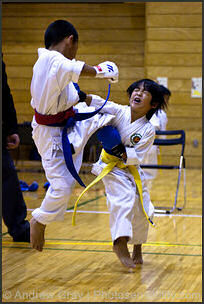
Karate training Hazing, sometimes called “kawaigari” (“loving care”) is common is all school- and university-level sports, even cheerleading. In July 2007, a male cheerleader at Meiji University committed suicide after being forced by older cheerleaders to strip naked and was videotaped doing it. Reports also surfaced of younger cheerleaders being hit in the face, chased with fireworks and forced to eat grass. After the suicide Meiji’s cheerleading squad was forced to disband.
Punishment and humiliation are intrinsic parts of sumo training. Wrestlers who have been deemed as not hard working enough are beaten by senior wrestlers with fists and bamboo poles and even metal shovels. Those that retreat are hit harder and taunted by the other wrestlers. Yokozuba Asashoryu who has been accused of whacking fellow wrestlers on the head with bamboo poles told the Los Angeles Times, “You have to be strict to make them try harder.”
The training and lifestyle for high school baseball players can also be quite rough. It is common for older baseball players on high school and college teams to haze younger players, sometimes quite brutally, and coaches to harshly punish players for making mistakes such as requiring them to shave their heads. One high school coach in Wakayama was suspended after he kicked two players after they made mistakes during a practice game.
Naoki Ogi, a professor of education ay Hosei University in Tokyo, told the Washington Post: “This happened all across the country in schools and workplaces, and its is probably one of he cultural characteristically we have in Japan.” Ogi said the practice has its roots in the militarism that was pervasive in wartime and pre-World-War-II Japan
Japanese Companies and Team Sports
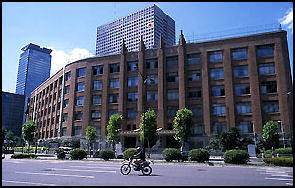
Ministry of Education, Sports.... Corporate sponsorship has long been a major pillar of sports in Japan, supporting everything from little league baseball to company rugby teams to major soccer and motorsports teams. In many cases sports are so dependent on this money they would struggle or cease to exist without it.
In addition to professional sports teams, Japan also has a large number of company teams with first-rate players, cheerleaders and mascots, and extensive media coverage. "After World War II," reported the Wall Street Journal, "when companies wanted to instill maximum employee loyalty, and people wanted cheap entertainment after a hard day's work, some companies spent about $3 million a year on uniforms, ball parks and pro-quality players."
"As Japan grew rich, the companies spent more on serious fun. Company baseball, volleyball, football, basketball and ping-pong teams became key parts of the national image. The best college players were eagerly recruited...as were top foreign players. With player salaries sometimes exceeding $200,000, mere office work necessary to ensure amateur status — was a costly waste of time. Most players spent only a few hours a week behind a desk."
Corporate teams are supposed to be made only of amateur players. But this is as much the case as it is in the Olympics. It is estimated that “amateur” players on corporate basketball teams earn around $200,000 a year.
Local sports clubs and private companies are stepping up their efforts to groom young athletes for national and international competitions as a way of bringing attention to their localities.
Decline of Company Sports in Japan
During the recession in the 1990s many companies were forced to cutback on their expenses for sports. Some of the better players were able to transfer to companies that kept their sports teams. Others stayed with their companies, quit sports, and became regular salarymen.
In corporate and industrial baseball only 80 teams are left from 237 in the early 1990s. Some players have gone to the United States and found spots on minor league teams. Players in other sports have had to get regular sports.
The economic crisis in 2008 and 2009 caused many companies to give up their company sports teams and cut back on their sponsorship money even more. Among those affected was the 37-year-old Seibu Prince Rabbits hockey team The team cost $5.1 million a year to maintain but only drew an average of around 1,000 people to its games. The team was 11-time national champs and Asian League champion twice, and had been around since Japan’s top hockey league was launched in 1966.
To keep teams and leagues alive, players started managing their own teams and found new sponsors and fans organized petition drives to urge companies to continue funding their teams. One American football team collected trash in a park to draw attention to its plight.
Other casualties of the global financial crisis in 2008 and 2009 have been Honda’s Formula One team and Mitsubishi’s and Suzuki’s rallying teams.
Japanese Sports Companies
Kobe-based Asiacs is a major athletic shoemaker with sales all over the world. It has a long way to go to compete with Nike and Adidas but has watched its sales grow sales year after year. In 2006, it racked up sales of ¥79 billion in Japan and ¥115 billion overseas. Over 88 percent of the overseas sales was in shoes. In Japan, shoes account for about for 42 percent of sales with clothing making up 40 percent of sales and other stuff 18.5 percent. Asiacs is an acronym for “Anima Sana In Corpore Sano,” which means “a sound mind in a sound body.” Many of its shoes are sold under the name Onitsuka Tiger.
Asiacs was established in 1949 by war veteran Kihachiro Onitsuka, who still serves as the company’s chairman. The company began making children’s sporting shoes and then basketball shoes. It opened its first European subsidiary in 1970 and adopted the name Asiacs in 1977. Among the athletes that wear Asiacs shoes Ichiro Suzuki of the Seattle Mariners and Olympics marathon gold medalist Naoko Takahashi.
Swimming suits were a major issue before the Olympics in Japan as they were elsewhere. Japanese swimmers had an agreement with Japanese sportswear companies to wear their suits. When swimmers began destroying word record with Speedo’s revolutionary LZR swimsuits the Japanese sportswear companies — Mizuno, Asics and Descente — began scrambling to quickly make speedy swimsuits of their own.
They experimented with new fabrics — including ones designs with the help of NASA and a super-fast synthetic rubber supplied by scuba wet suit maker — but were not able to make any breakthroughs and in the end allowed swimmers to wear any swimsuit they wanted with many of them selecting the LZR.
The decision to allow Japanese swimmers to use the LZR was made after Kitajima broke the world record in the 200 meter breaststroke wearing an LZR and 16 of 17 national records at a meet to decide who would go tp the Beijing Olympics were broken by swimmers wearing LZR suits. On the suits, Kitajima said, “If you are a competitive swimmer it’s only natural to want to wear a suit that give you speed.” There were concerns hat Japanese swimmers might fail to win a medal if they didn’t wear the Speedo suits.
Sports and the Earthquake and Tsunami in 2011
A number of sporting events — including the World Figure Skating Championship, the Tour of Japan bicycle race — scheduled to be held in Japan in 2011 were either canceled, postponed or moved somewhere else in the wake of the earthquake and tsunami that year. The World Figure Skating Championship was moved to Russia. Japan was later given the nod to host the event in 2014. An effort was made to keep the world gymnastic championship in Tokyo in October 2011.
A big deal was made when baseball returned to earthquake- and tsunami-devastated Sendai and the home team Rakuten Eagles won 3-1 behind their new ace pitcher Masahiro Tanaka at Kleenex Stadium. J-League resumed soccer games in late April.
Image Sources: Andrew Gray Photosensibility except baseball (Japanball.com)
Text Sources: New York Times, Washington Post, Los Angeles Times, Daily Yomiuri, Times of London, Japan National Tourist Organization (JNTO), National Geographic, The New Yorker, Time, Newsweek, Reuters, AP, Lonely Planet Guides, Compton’s Encyclopedia and various books and other publications.
Last updated August 2012
